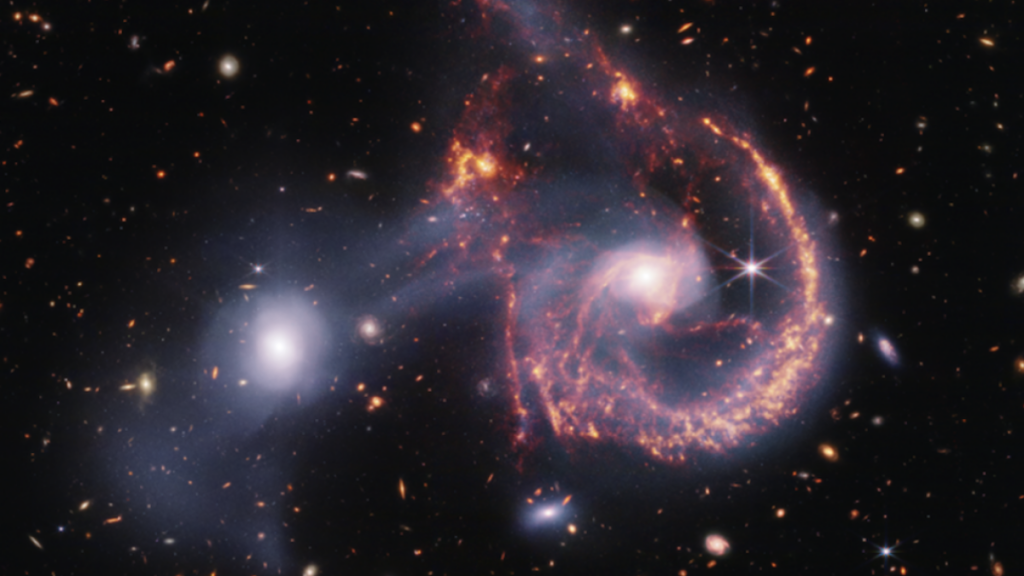
Webb telescope reveals a bridge between 2 galaxies after big collision (Image Credit: Mashable)
Here’s what you’re seeing in Webb’s new image, which shows an event transpiring 450 million light-years way:
– Older stars and the bridge: The white areas are older stars, which you can see plenty of in both the galaxies. These stars also make up the “tenuous bridge of gas and stars that runs between [the galaxies],” the European Space Agency (ESA) explained.
– Vibrant star formation: When galaxies collide with one another, their gasses meet and condense. The resulting weighty clouds of gas can collapse, driving the formation of new stars. In this image, Webb’s Mid-Infrared Instrument reveals these expansive star-forming regions in orange and red.
– Deep space galaxies: Nearly all those objects in the background are distant galaxies — many spirals like ours — each teeming with their own stars, and likely planets.

Credit: NASA / ESA / CSA / STScI
On Wednesdays we wear pink. 💖
Arp 107, an interacting galaxy pair, was captured by Webb in both the near and mid-infrared, the latter represented in pinkish hues. What does each infrared wavelength tell us? ⬇️ https://t.co/8wSmKFA32o pic.twitter.com/F8LT07k45K
— NASA Webb Telescope (@NASAWebb) September 18, 2024

Credit: NASA / Chris Gunn
The Webb telescope’s powerful abilities
The Webb telescope — a scientific collaboration between NASA, ESA, and the Canadian Space Agency — is designed to peer into the deepest cosmos and reveal new insights about the early universe. But it’s also examining intriguing planets in our galaxy, along with the planets and moons in our solar system.
Here’s how Webb is achieving unparalleled feats, and likely will for decades to come:
– Giant mirror: Webb’s mirror, which captures light, is over 21 feet across. That’s over two-and-a-half times larger than the Hubble Space Telescope’s mirror. Capturing more light allows Webb to see more distant, ancient objects. The telescope is peering at stars and galaxies that formed over 13 billion years ago, just a few hundred million years after the Big Bang. “We’re going to see the very first stars and galaxies that ever formed,” Jean Creighton, an astronomer and the director of the Manfred Olson Planetarium at the University of Wisconsin–Milwaukee, told Mashable in 2021.
– Infrared view: Unlike Hubble, which largely views light that’s visible to us, Webb is primarily an infrared telescope, meaning it views light in the infrared spectrum. This allows us to see far more of the universe. Infrared has longer wavelengths than visible light, so the light waves more efficiently slip through cosmic clouds; the light doesn’t as often collide with and get scattered by these densely packed particles. Ultimately, Webb’s infrared eyesight can penetrate places Hubble can’t.
“It lifts the veil,” said Creighton.
– Peering into distant exoplanets: The Webb telescope carries specialized equipment called spectrographs that will revolutionize our understanding of these far-off worlds. The instruments can decipher what molecules (such as water, carbon dioxide, and methane) exist in the atmospheres of distant exoplanets, be they gas giants or smaller rocky worlds. Webb looks at exoplanets in the Milky Way galaxy. Who knows what we’ll find?
“We might learn things we never thought about,” Mercedes López-Morales, an exoplanet researcher and astrophysicist at the Center for Astrophysics-Harvard & Smithsonian, told Mashable in 2021.
Already, astronomers have successfully found intriguing chemical reactions on a planet 700 light-years away, and have started looking at one of the most anticipated places in the cosmos: the rocky, Earth-sized planets of the TRAPPIST solar system.
Topics
NASA





